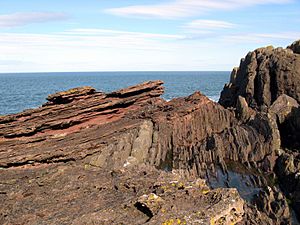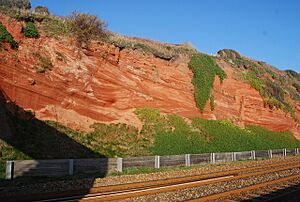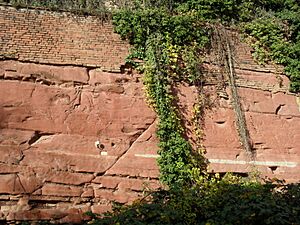Red beds facts for kids


Red beds are special kinds of rocks that look reddish. They are usually sedimentary rocks, like sandstone, siltstone, or shale. These rocks get their red color from iron oxide, which is like rust.
Red beds usually form in hot places on land, or near rivers and lakes. They need conditions where there's a lot of oxygen in the air. This helps the iron in the rocks turn red.
Even though red beds can form at different times, many famous ones come from the Devonian, Permian, and Triassic periods. One very well-known example is the Old Red Sandstone.
Red beds are important because they can sometimes hold valuable resources. For example, some red beds contain hidden stores of petroleum (oil) and natural gas.
How Red Beds Form
The red color in these rocks comes from a chemical change called oxidation. This is the same process that makes metal rust when it's exposed to air and water.
Scientists used to think that red beds only formed in deserts. While some do, like those with ancient dunes, we now know they can form in other hot places too.
Today, you can find red beds forming in warm, tropical areas. These places often have lots of rain, but it might come in certain seasons, like during monsoons. A good example of where red beds are forming today is the Amazon basin in South America. Here, the warm, wet conditions help the iron in the soil and rocks turn red.
Related pages
Images for kids
-
Cathedral Rock near Sedona, Arizona, made of Permian redbeds.
-
Red beds surround Devils Tower National Monument.






